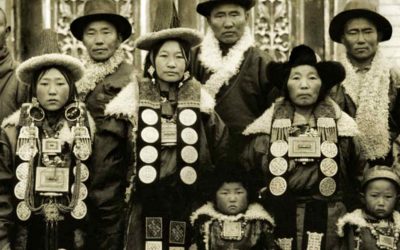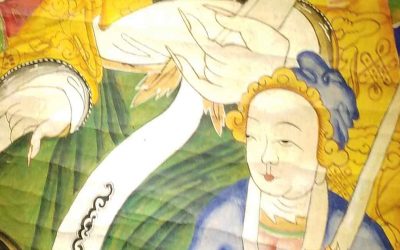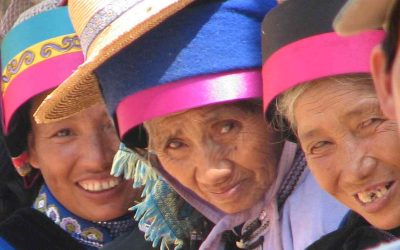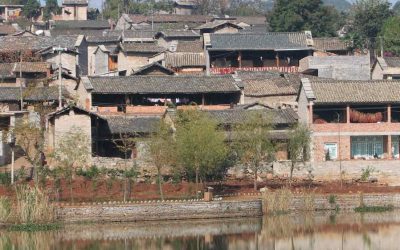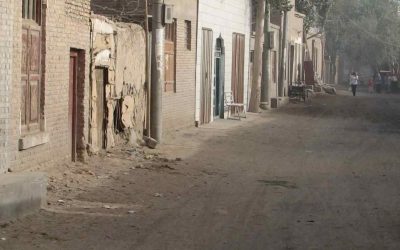The Monastery of Sera – History and foundation
Sera Monastery, located on the outskirts of Lhasa, is one of the largest monasteries in Tibet, and one of the most important centers of learning. Still today many young Tibetans come to the monastery to be trained in the mysteries of Tibetan philosophy and religion, and on visits to this monastery, included in most tours, it is normal to have the opportunity to see monks discussing aspects of doctrine, or some of the printing press rooms that once made this center of learning famous.
Here we have selected part of the article that the Hindu Tibetologist Sarad Chandra Das wrote in 1905 about the monasteries of Tibet (Journal of the Asiatic Society of Bengal.).
The monastery of Sera (literally, wild rose) was founded by Cham-chen-choije Sakya Yeceg in 1418, the year of Tsongkhapa’s death.
The Governor Nehu-pa who patronized Tsongkhapa and his disciples frequently used to invite them to Sera-tse, a retired hermitage on the top of the hill overhanging Sera. On these occasions, Choije devotedly served the reformer, in consequence of which Tsongkhapa predicted a great future for a monastery which Choije would found in that neighbourhood. A saintly Lama while sitting in meditation, cast his eyes on a spot lower down the hermitage which was filled with wild rose plants in blossom. He predicted that someday there would be a monastery there.
Visit to Beijing
Emperor Yongle of the Ming dynasty had sent an invitation to Tsongkhapa to visit Peking; but the great reformer, finding Choije’s time fully occupied with the more important work of religious reformation, sent Cakya Yeces as his representative. Yongle did honour to the Yellow-cap Church by showing every consideration to this disciple of the reformer on his arrival at Peking where Choige’s first act was to bring about the recovery of the Emperor from a serious illness by the efficacy of his religious services. The temple of Maitreya, then recently built by the Emperor, was placed in his charge and he was given the name of Chyam-chen Choije. Under the Imperial auspices, Choije founded the monastery of Hwang-si (Yellow-temple) in one of the imperial gardens of Peking situated a few miles to its north. For diffusing the reformed creed of Tsongkhapa in China he had taken with him several of Tsongkhapa’s works and a set of block-print Kahgyar [113] scriptures. After converting the Lamas of Peking to the reformed Yellow-cap Church he returned to Tibet. On the way, he paid his reverence to Tsongkhapa making rich presents to him. Subsequently, he founded the monastery of Sera Theg-chen-ling, which now contains 5,500 monks and exercises much influence in the secular and religious administration of the country.
Sera University
He established a university in it with four Tva-tshang or colleges. Of these Gya-Tva-tshang belonged to the upper division of Sera and the remaining three, i.e., Thoisam, Norpuiling, Chyipa Khamang Tva-tshang, and Nag-pa Tra-tshang belonged to Sera Mah, (sma) z.e., lower division of Sera. In the middle of the eighteenth century, two of the colleges were established. It still continues to be a favourite resort of learned men of Tibet and Mongolia. The monks of Sera belong to respectable families of Tibet proper, Amdo, Kham, Nyagrong, Mongolia, and Western China.
Main art treasures
There are in the Dukhang (grand hall of the congregation) the images of —
- Buddha vanquishing Mara the evil one and a host of demons.
- The sixteen Sthavira (Neh-tan Chu-rig!) brought from China.
- Several life-like images constructed by the famous artist Nehu Chang-wa.
In the Gonkhang (the temple assigned to the Tantrik deities) there are—
- The image of the six-armed Bhairava, constructed by Leg-an of Shwau.
- Gon-po Choigyal with four arms.
- The goddess Paldem Lhamo (Kali) on horseback, her legs being tied by a chain, probably as a punishment for her wicked conduct.
In the front wall, there are painted representations of the invasion of U by the Tsang army and their defeat by the Tartars in 1643, the scenes of war, and the images of fearful spirits, such as Gon-po De-mar, the genius (Chyarog-dong-chan, he with a raven’s head), etc. On the western wall are painted the likenesses of the successive high priests of Sera, etc.
In the western corner of the upper congregation hall (Duk-hang Gong-ma), are the images of Amitabha Buddha, the eleven-armed Avalokitesvara and the four-armed Gon-po, Maitreya made of silver, the Bodhisattva (Cakya) as a citizen, and the eight spiritual sons of Buddha and also the Kah-gyur and Tangyur collections, all written in gold and silver.
In the temple of Chyam-chen Shal-reh Lhakhang, the image of Atisha with a Chintamani wishing-gem in his hand is conspicuous.
In the Go-chye-khang there are images of Buddha and a silver Chorten. In the further niché of the Dukhang there is a golden image of the coming Buddha. In the front hall of the ukhang there are the Dharma Pala. The most remarkable object in the passage of circumambulation round the monastery is a small Chattya (said to be one of the 84,000 chattya constructed by Emperor Asoka) which was brought from Magadha. There is also a Tantrik image of Hayagriba with the goddess Vajra Varéhi in his clasp.
Last posts
There was a matriarchy among the Yugur?
There was a matriarchy among the Yugur? The matrimonial customs of the Yugur present differences between their two main groups. Among the Eastern Yugur, girls had a time of great sexual freedom. Their rite of passage was the ceremony of making the headdress, which was...
The Yugur of Gansu, descendants of the Kings of Dunhuang
o The Yugur of Gansu, descendants of the Kings of Dunhuang Name. Their Chinese name is Yugu, written 裕 固 族. The Yugu or Yugur call themselves Yaoyuer and Xilayuguer. The name Yugur is relatively recent, as it only began to be used after 1949. Population: About 13,000...
Two stories of Liu Ba, the Bai trickster
Two stories of Liu Ba, the Bai trickster The Bai are one of the minorities who have had the longest contact with the Chinese.They are also one of the minorities that has received more cultural influences. This has been due to the accessibility of the land they...
The history of the Sani of the Stone Forest
The history of the Sani of the Stone Forest As told by father Paul Vial in his book Les Lolos, Histoire, religion, mœurs, langue, écriture. The Lolos say they came from the region between Tibet and Burma, and at the very beginning of their history, they...
Danuohei, the stone village of the Sani minority
Danuohei, the stone village of the Sani minority Danuohei Village - (大糯黑村) is a Sani minority village. The Sani minority, actually a branch of the Yi, lives in the whole area around the Stone Forest until reaching Puzhehei, where one can also visit some beautiful...
The Baoan, master sword makers in the Silk Road
The Baoan, master sword makers In the dry lands of Gansu province, at the foot of the Jishishan mountain, there are three villages inhabited by different people. At first glance, their life is the same as that of any other Muslim population in that vast region crossed...





